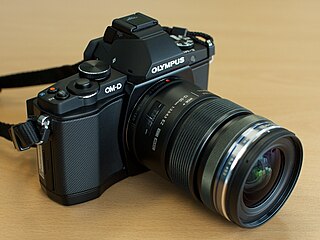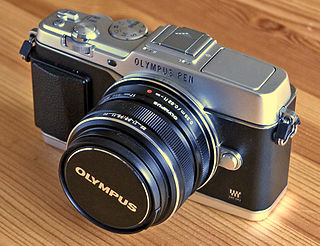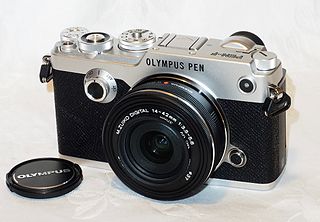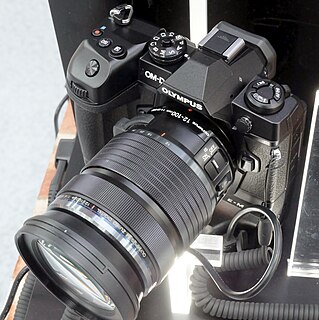
The Four Thirds System is a standard created by Olympus and Eastman Kodak for digital single-lens reflex camera (DSLR) and mirrorless camera design and development.

A digital single-lens reflex camera is a digital camera that combines the optics and the mechanisms of a single-lens reflex camera with a digital imaging sensor.

The Pen, or PEN series is a brand of Olympus. It was used on analog half-frame compact and SLR models from 1959 until the early 1980s. In 2009, Olympus released the PEN E-P1, a digital mirrorless interchangeable-lens camera, which opened the range of Digital PEN models, which are still sold today. Olympus Corporation's camera division since has been bought by Japan Industrial Partners, and run under the OM Digital Solutions name. They continue to run the Digital PEN series.

The Micro Four Thirds system is a standard released by Olympus and Panasonic in 2008, for the design and development of mirrorless interchangeable lens digital cameras, camcorders and lenses. Camera bodies are available from Blackmagic, DJI, JVC, Kodak, Olympus, Panasonic, Sharp, and Xiaomi. MFT lenses are produced by Cosina Voigtländer, DJI, Kowa, Kodak, Mitakon, Olympus, Panasonic, Samyang, Sharp, Sigma, SLR Magic, Tamron, Tokina, TTArtisan, Veydra, Xiaomi, Laowa, Yongnuo, Zonlai, Lensbaby, Kowa, Venus Optics and 7artisans amongst others.

The Panasonic Lumix DMC-GH1 is a digital mirrorless interchangeable lens camera adhering to the Olympus and Panasonic developed Micro Four Thirds System (MFT) system design standard. Panasonic classified the GH1 as a hybrid stills/video camera and the GH1 was introduced and marketed as a higher end camera than Panasonic's first MFT camera, the stills only, non-video capable Lumix DMC-G1.

The Olympus Pen E-P1 announced on 16 June 2009 is Olympus Corporation's first camera that adheres to the Micro Four Thirds (MFT) system design standard. The first camera to use the Micro Four Thirds mount was Panasonic's G-1 camera.

A mirrorless camera is a photo camera featuring a single, removable lens and a digital display. The camera does not have a reflex mirror or optical viewfinder like a digital single-lens reflex (DSLR) camera, but may have an electronic viewfinder. Many mirrorless cameras retain a mechanical shutter. Like a DSLR, a mirrorless camera accepts any of a series of interchangeable lenses compatible with its lens mount.

The Olympus OM-D E-M5, announced in February 2012, is a Micro Four Thirds compact mirrorless interchangeable lens camera. In style and name it references the Olympus OM series of film SLR cameras, but it is not an SLR camera. The successor is the Olympus OM-D E-M5 Mark II.

The Olympus PEN E-PL5, announced on September 17, 2012 is Olympus Corporation's tenth camera that adheres to the Micro Four Thirds (MFT) system design standard. The E-PL5 succeeds the Olympus PEN E-PL3, and was announced in concert with one other model, the Olympus PEN E-PM2.

The Panasonic Lumix DMC-GX7 announced in August 2013, is a Micro Four Thirds compact mirrorless interchangeable lens camera. It was Panasonic's first Micro Four Thirds camera with a built-in in-body stabilization system (IBIS) and has a built-in EVF. Panasonic uses 2-axis in-body stabilization allowing the use of shutter speeds 1 to 2 stops slower than without stabilization, compared to the 4 to 5 stops of improvement offered by Olympus' 5-axis stabilization.

The Olympus OM-D E-M1 Micro Four Thirds is Olympus' compact mirrorless interchangeable-lens camera introduced on September 10, 2013. It has built-in on sensor phase detection.

The Sony α7, α7R, α7S and α7C are four closely related families of full-frame mirrorless interchangeable-lens cameras. The first two were announced in October 2013, the third in April 2014 and the fourth in September 2020. They are Sony's first full-frame mirrorless interchangeable lens cameras and share the E-mount with the company's smaller sensor NEX series.

The Olympus PEN E-P5 is a mirrorless interchangeable-lens camera in the micro four thirds system released in October 2013. This is, despite its number, the fourth model in the PEN E-P range. It remained the latest model in the E-P series until the introduction of the E-P7 in the summer of 2021. It includes the same 16 MP sensor as the Olympus OM-D E-M5. The E-P5 comes in three colour schemes; black, silver and white.

The Olympus OM-D E-M5 Mark II is a digital interchangeable-lens camera announced in February 2015. It features a new 40-megapixel high-resolution mode that uses sensor shift to generate overlapping 16-megapixel images to then compute a 40-megapixel composite. It is the successor of the Olympus OM-D E-M5. Compared to that earlier model from 2012 and flagship OM-D E-M1 released in 2013, both of which are claimed to have 4 f-stops of shake compensation when shooting handheld, Olympus claims the OM-D E-M5 II can compensate 5 f-stops.

The Olympus PEN-F is a mirrorless interchangeable-lens camera in the Micro Four Thirds system, released in 2016. It is the part of the digital PEN series. The PEN-F pays tribute to the similarly named PEN F half-frame 35mm film SLR camera from 1963.

The Olympus OM-D E-M1 Mark II is a digital mirrorless interchangeable-lens camera released by Olympus Corporation in December 2016. It replaced the Olympus OM-D E-M1, which was introduced in 2013.

The Olympus OM-D E-M1X is a professional mirrorless interchangeable-lens camera announced by Olympus Corporation in January 2019.

Pixel shift is a method in digital cameras for producing a super resolution image. The method works by taking several images, after each such capture moving ("shifting") the sensor to a new position. In digital colour cameras that employ pixel shift, this avoids a major limitation inherent in using Bayer pattern for obtaining colour, and instead produces an image with increased colour resolution and, assuming a static subject or additional computational steps, an image free of colour moiré. Taking this idea further, sub-pixel shifting may increase the resolution of the final image beyond that suggested by the specified resolution of the image sensor.

The Olympus OM-D E-M10 Mark IV is the fourth iteration of the entry-level model in the OM-D series of mirrorless interchangeable-lens cameras produced by Olympus. The camera utilizes the micro four-thirds system and was announced on August 4, 2020, and launched on September 18 of the same year.

The Olympus OM-D E-M1 Mark III is the third iteration of the flagship camera in the series of OM-D mirrorless interchangeable-lens cameras produced by Olympus on the Micro Four-Thirds system. Released on February 28, 2020, it replaced the Olympus OM-D E-M1 Mark II.




















